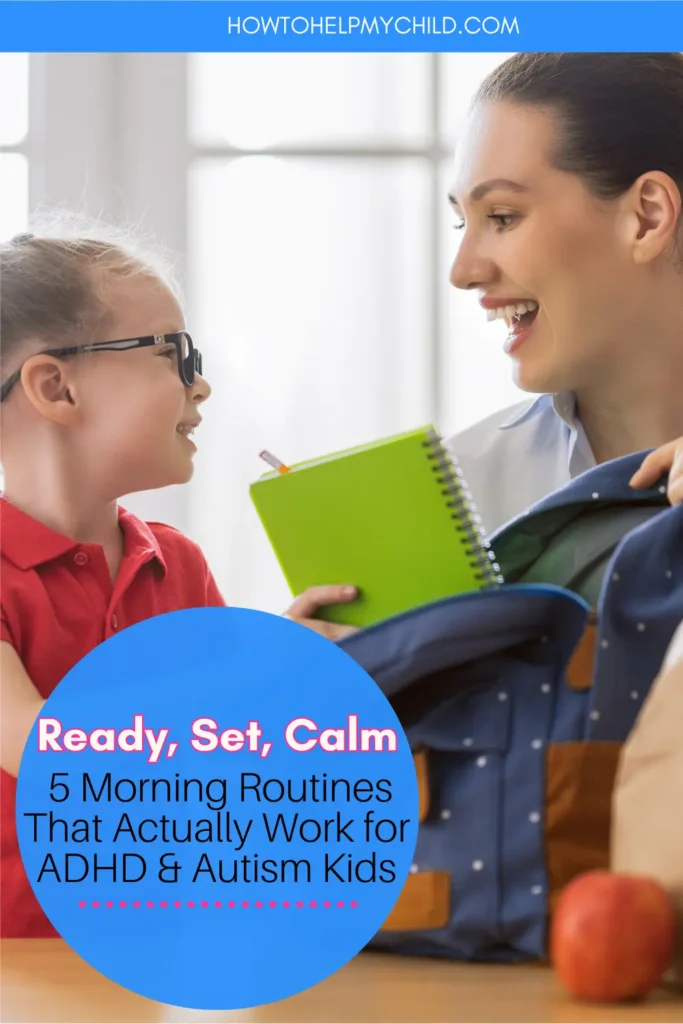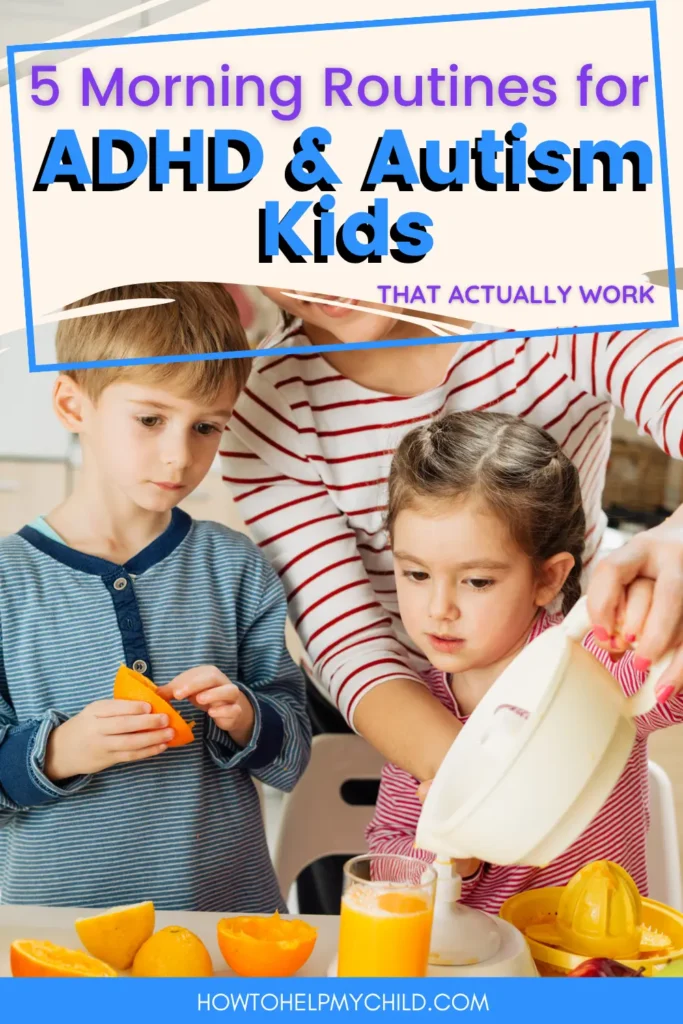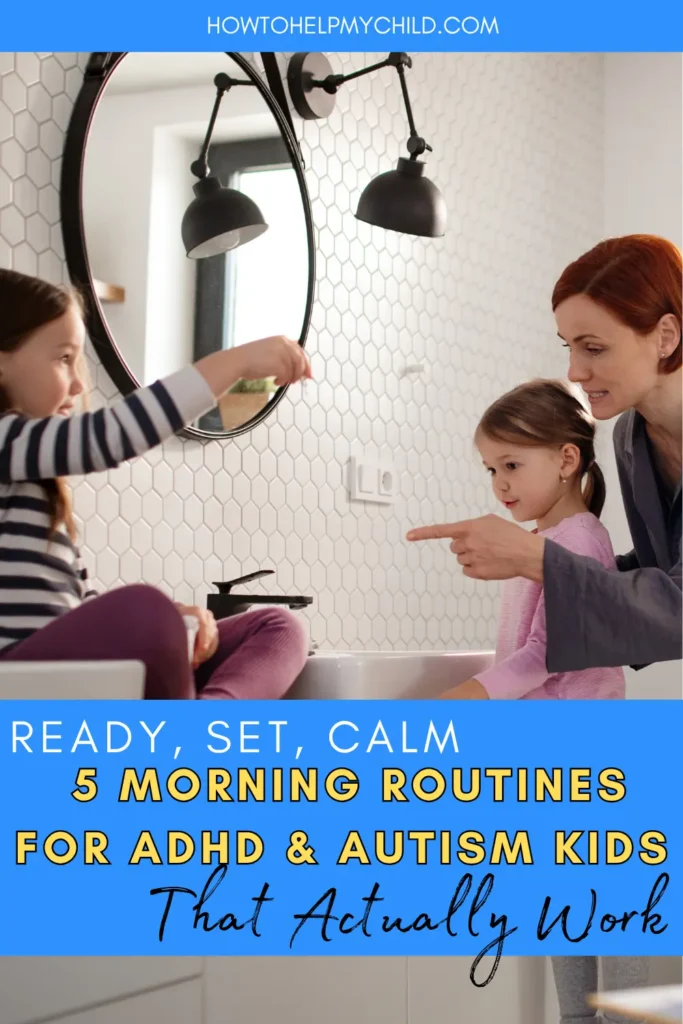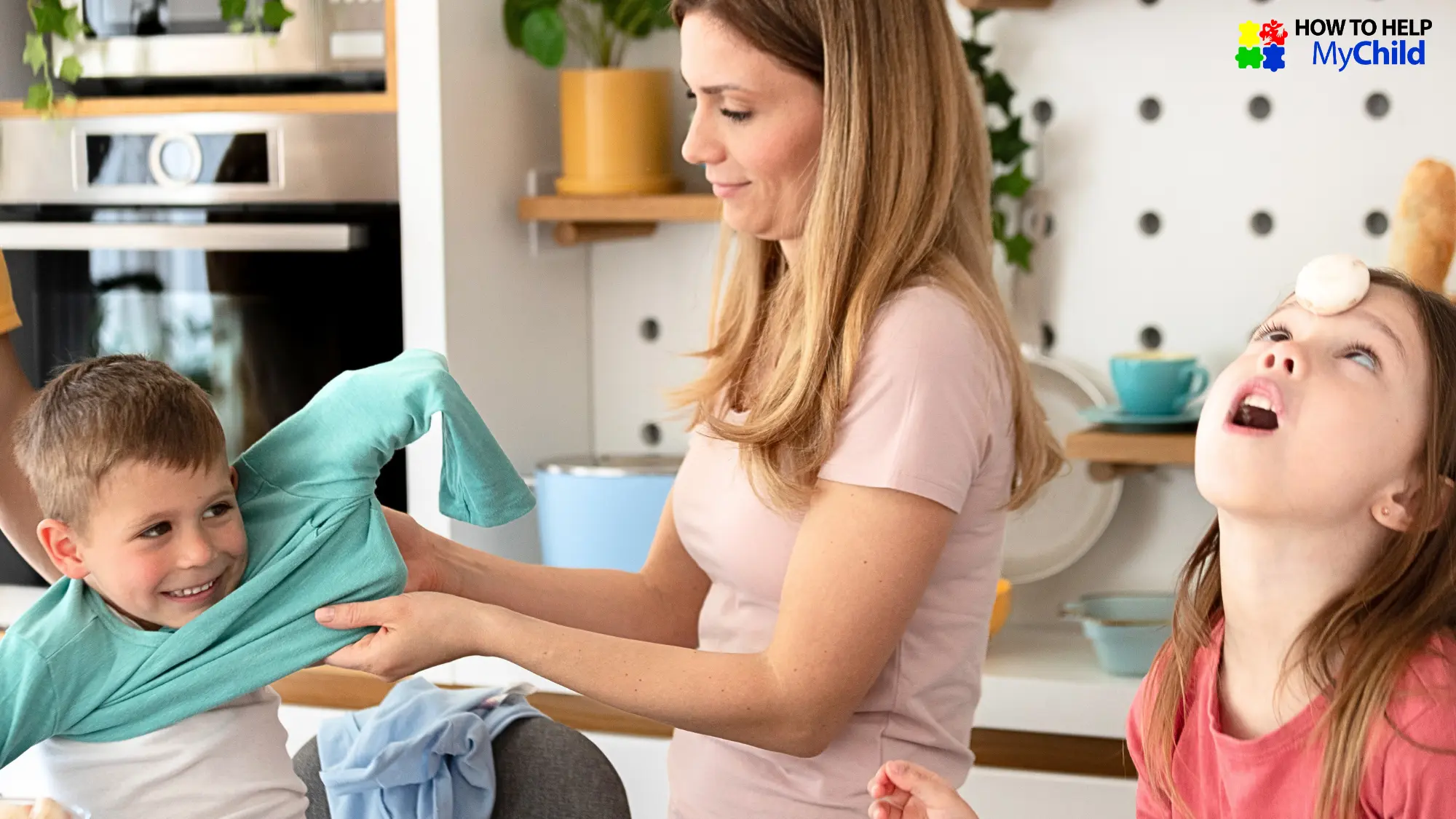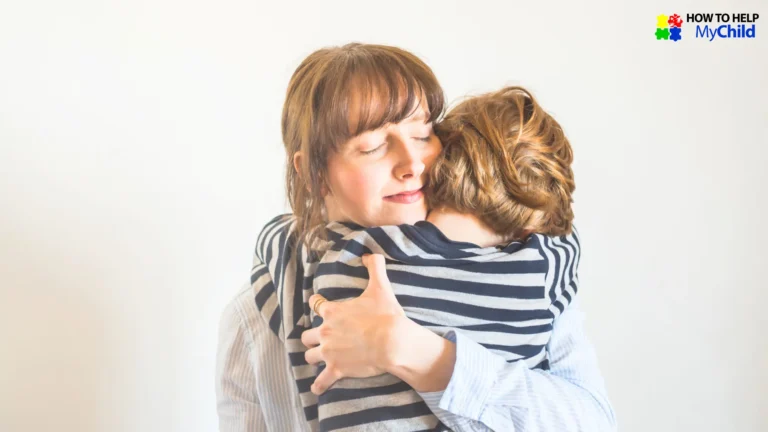Ready, Set, Calm: 5 Morning Routines That Actually Work for ADHD & Autism Kids
If mornings feel more like a battlefield than a fresh start, you’re not the only one crying in the school car park.
Trust me – you’re not the only one!
For many families raising children with autism or ADHD, morning routines are a whirlwind of mismatched socks, meltdowns, and toast that was supposed to be cut in triangles.
Do you feel like you are always running late, managing meltdowns, and like you have already done a full day’s work before 9 a.m.?
It is exhausting.
But here’s the truth: it doesn’t have to be this way.
At How to Help My Child, I’ve supported hundreds of moms who’ve felt that same mix of exhaustion, overwhelm and guilt all before the school bell rings.
I have also seen how powerful it can be to make a few small changes, rooted in how your child’s brain actually works, that can transform the entire tone of the day.
Mornings don’t have to feel chaotic.
They can be calmer, more predictable, and even, dare I say, peaceful.
But Mom,
this isn’t about perfection.
It’s about progress.
And peace.
The Morning Routine Struggle Is Real
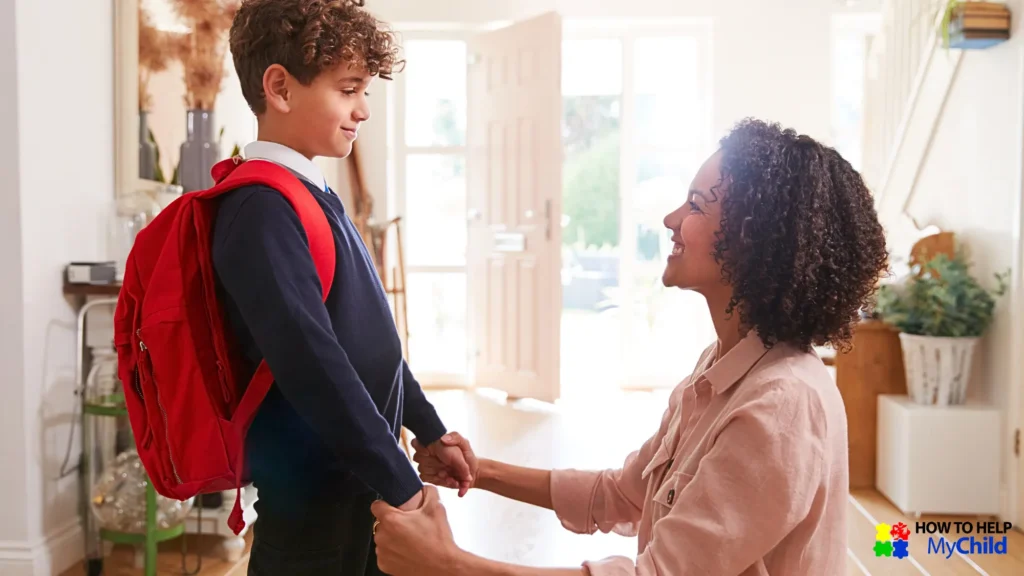
Getting out the door in the morning is rarely easy, especially when your child’s neurodivergent needs come with sensory sensitivities, executive functioning challenges, or resistance to transitions.
For many families, it’s a time filled with tension and frustration.
You’re trying to manage school bags, toast that isn’t cut quite right, socks that suddenly feel “wrong,” and a clock that just won’t stop ticking.
But morning routines don’t have to start this way.
They really don’t.
Let me tell you about Annie, a mom I worked with who used to feel like she was losing the morning battle every single day.
Her son would refuse to get dressed,
breakfast became a standoff,
and drop off ended in tears,
sometimes hers, sometimes his.
They were both frazzled.
She rang me one morning after sobbing in the school car park.
“I can’t keep doing this,” she said.
Together, we started working on some simple, practical changes.
Nothing dramatic, just tools that respected her child’s needs and made space for more structure and predictability.
Slowly, mornings shifted.
Bit by bit, the chaos softened and they found a rhythm that worked.
Their mornings aren’t perfect, but they’re not filled with dread anymore.
And that’s what I want for you, too.
📺 Prefer to watch instead? Check out the video guide:
1. Visual Schedules: A Gentle Guide for Your Morning Routine

Why Visual Schedules help:
Many of our neurodiverse kids struggle with executive functioning.
The brain’s ability to organize, sequence, and carry out multi-step tasks.
So Mom, when you say, “Brush your teeth, get dressed, and pack your bag,”
your child might only hear “noise.”
That’s not defiance, it’s a processing overload.
Visual schedules help to take the pressure off your autistic and ADHD child’s working memory and give the brain something concrete to follow.
Our children with autism and ADHD often feel anxious in the morning because they don’t know what’s coming next, or how long it will take.
Their brain might struggle to hold multiple steps in working memory, especially under time pressure.
Visuals create clarity, reduce anxiety, and build independence.
All without you needing to repeat yourself ten times – so no more nagging!.
This simple support reduces your child’s fears, increases their confidence, and limits the need for repeated instructions.
It gives your child a clear, solid map of the morning routine,
and cuts down on those “What now?” moments.
It tells your child, “This is what we’re doing, and here’s what comes after.”
Visual schedules are game changers for many of our neurodivergent kids.
What might feel like “nagging” to you is often just too much verbal input for your child’s brain to hold onto, especially during busy, noisy mornings.
If your child with autism or ADHD often struggles with their ability to plan, prioritize, and move through multi-step tasks, it’s a good sign they are having issues with executive functioning.
That’s where a visual schedule steps in.
💡TIP
If your child struggles to start tasks on their own, walk through the schedule with them for a few days until it becomes familiar. You’re not “doing it for them”, you’re co-regulating them through the learning curve.
Because many of our neurodivergent kids are visual learners, they process visual information more efficiently than verbal instructions.
Especially when stress or sensory overload kicks in.
Visual schedules are more than just a cute set of icons.
They show your child what’s expected and what’s coming next.
They’re a powerful communication tool for kids who thrive on structure and predictability.
Instead of repeating yourself over and over, your child has something they can see, touch, and return to.
And that clarity?
It can transform even the most chaotic morning routines.
Visual Schedules support:
- Children who thrive with routine and predictability
- Visual learners (common in autism)
- Kids who shut down when overwhelmed
How to Create a Morning Visual Schedule:
- Break the morning into 4 to 6 simple tasks,
like brushing teeth, getting dressed, eating breakfast, packing bags, and putting on shoes, - Use photos, icons, or stick figures your child relates to,
- Include a “done” column to move items over – that physical action gives a dopamine boost,
Place it where they’ll see it – fridge, mirror, or by their bed.
💛 From a Mom in Our Community:
“I used to feel like a broken record every morning—’Brush your teeth! Get dressed!’ Now my son checks his visual schedule on the fridge and does everything without me saying a word. It’s been a game changer for both of us.”
– Lisa, mom of 7-year-old Jonah
2. Timers: Creating Structure Without Pressure
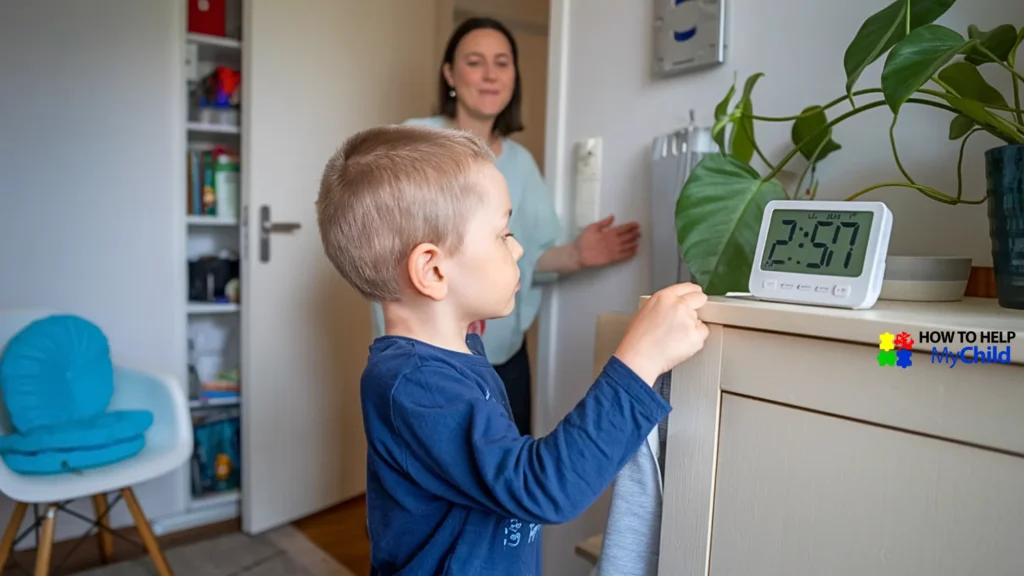
Why Timers help:
Kids with ADHD or autism often experience what’s called “time blindness.”
Their brain doesn’t register time passing the way neurotypical brains do.
Time is abstract for many neurodivergent kids.
Five minutes may feel like forever – or no time at all.
That means transitions – especially sudden, unexpected, ones – can feel jarring or even panic inducing.
Timers give time a shape, a sound, a visual.
Timers help make time visible and predictable.
That creates emotional safety, reduces stress and helps your child pace themselves during transitions.
Timers help our kids anticipate transitions instead of being surprised by them.
Which lowers their anxiety and builds independence.
💛 From a Mom in Our Community:
“We started using a visual timer for dressing and brushing teeth. Ava used to panic when I rushed her, but now she watches the timer and says, ‘I’ve got time!’ It’s given her a real sense of control.”
– Megan, mom of 6-year-old Ava with ADHD
Timers support:
- Transition resistance
- Anxiety around sudden change
- Kids who hyperfocus and lose track of time (hello, ADHD!)
Use timers to:
- Set a visual countdown for getting dressed or brushing teeth
- Transition gently from preferred activities to non-preferred ones
- Replace verbal nagging with an external cue — the timer becomes the “boss,” not you
Timer Types to Try:
Visual timers with disappearing colors
Phone apps with fun alerts
A basic kitchen timer or stove timer
Try using Timers for:
3 minutes for brushing teeth
10 minutes for getting dressed
15 minutes for breakfast
Timers can also reduce so much conflict.
Instead of, “Come on! Hurry up!”
you can say,
“Let’s see how much you can do before the timer beeps.”
Remember – timers aren’t just tools.
They’re teachers.
Timers help your child feel the passing of time, which supports executive functioning and self-regulation over time.
💡TIP
Some kids may need to see the timer. Others might do better with a fun sound at the end. Try a few different styles and see what calms, not pressures, your child.
3. Adding Joy & Positive Reinforcement
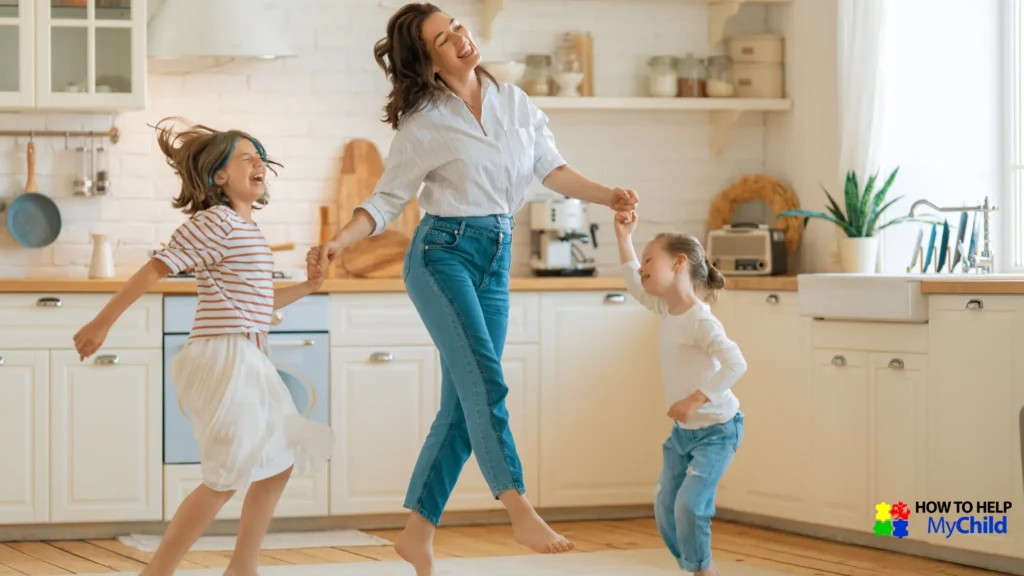
When mornings feel like a constant “NO,” your child’s nervous system enters defense mode.
But adding just a sprinkle of joy can shift the whole emotional climate.
Even one moment of connection can reset everyone.
Joy is also a motivator.
Kids with ADHD often have lower dopamine levels, and small bursts of fun or positive attention can help their brains engage more willingly in daily routines.
What joy helps with:
- Increases cooperation through connection
- Builds resilience and motivation over time
- Encourages your child to try (even when things are hard)
How to make morning routines more joyful:
- Celebrate small wins: “High five for brushing your teeth!”
- Reinforce effort with praise that is specific: “You zipped your coat by yourself – that shows focus and follow-through”
- Create a family morning mantra: “We do mornings with kindness”
- Let your child pick the music while they eat breakfast
A little joy goes a long way.
You’re not expected to throw a party every morning, but tiny moments of fun and praise can lighten the emotional load,for both you and your child.
💡TIP
Don’t overthink it. One tiny moment of joy, even a shared giggle, can soften the edges of a hard start.
Ways to Add Joy:
Sing a silly song while brushing teeth
Dance for 30 seconds after breakfast
Let your child be the “morning checklist captain”
Choose “themed” mornings – Pajama Friday or Smoothie Tuesday
💛 From a Mom in Our Community:
Our morning routine includes a dance break after breakfast. It started as a joke, but now my kids remind me if we forget! That 2 minute burst of joy helps everyone start the day on the right foot.”
– Anjali, mom of 2 neurodivergent kids

You’re Not Alone – Find Your Support System Here!
Parenting a child with autism or ADHD can feel isolating—endless meltdowns, sleepless nights, & feeling like no one understands But you don’t have to do this alone.
❣️Get real-life strategies to handle daily challenges.
❣️Connect with moms who get it—no judgment, just support.
❣️Share your wins (and struggles)
❣️Find encouragement, advice, & a place to vent when you need it most.
👉Join our private Facebook group today and step into a community that truly understands!
4. Prep the Night Before: Protect the Morning Peace

I know evenings are exhausting.
You’re not lazy for avoiding prep at night.
You are just exhausted.
After a full day of managing meltdowns, appointments, and school notes crumpled in the bottom of the bag, of course the last thing you want is to think about tomorrow.
But here’s the truth: just 5 to 10 minutes of low effort night time prep can dramatically change how your morning routine feels.
It’s not about being organized for Instagram, it’s about giving your future self a break and helping your child start the day feeling safe, prepared, and regulated.
For our neurodivergent kids, predictability lowers anxiety.
Knowing what’s coming and where things are, takes away some of the fear and frustration that often fuels your child’s morning resistance.
And for you, Mom?
It means less decision fatigue, fewer raised voices, and more calm before coffee.
Preparing the night before helps with:
- Easing transition anxiety — mornings feel safer when the unknowns are fewer
- Reducing pressure on you — fewer last-minute decisions and forgotten items
- Setting your child up for success — they feel more in control and less reactive
- Creating a calm, connected start, without needing to wake up any earlier
Try prepping:
Clothes or uniforms
Lunches and snacks (or parts of them)
School bags (packed and by the door)
Breakfast bowls or breakfast items set out, ready to eat
You can even create a “night prep checklist” to keep track of it all.
It helps to involve your neurodivergent child too.
Even young children can lay out socks or help pick tomorrow’s shirt.
It gives them ownership and eases morning resistance.
💡TIP
Start small. Let your child pick their socks for tomorrow or choose which breakfast bowl to use. That one moment of ownership can snowball into co operation the next morning.
How to expand night time prep:
Preview the morning routine with your child.
A simple walk through, “First we do breakfast, then get dressed,” can calm their brain before bed and plant a seed of co operation for the next day.
Create a “morning launch pad” – pick a basket, shelf, or corner by the door and place school bags, shoes, water bottles, hats, and anything else that usually goes missing at 8:13 a.m.
Use a shared checklist — make it visual and short.
You know I love visuals!
Let your child help with just one or two steps, like putting their lunchbox in their bag or choosing a snack.
Do a 5-minute “reset” ritual.
Turn on a song and do a quick team tidy: lay out clothes, line up shoes, and scan for any missing permission slips or library books.
Remember, it’s not about perfection, it’s about progress, comfort, and predictability.
💛 From a Mom in Our Community:
“I used to crash on the couch at night, then scramble through chaotic mornings. Now my son and I do a 5-minute ‘night setup’ after dinner. He picks his clothes, I pack his lunch. He knows what’s coming, I sleep better, and we haven’t lost a shoe in weeks.”
– Talia, mom of 8 year old Eli with autism, ADHD
5. Your Calm Sets the Tone: You matter too Mom

This one’s powerful: Your calm is contagious.
I know it’s hard when you’re tired, overwhelmed, or running behind.
But your energy becomes the emotional baseline for the morning routine.
Your Kids with autism and ADHD often rely heavily on co-regulation.
Which means they absorb your stress just as much as your calm.
Maintaining your calm behavior helps with:
- Modeling emotional regulation
- Creating safety through tone and body language
- Reducing reactive behavior and building connection
So when you feel grounded, Mom, even for just a moment, it gives your child something to anchor to.
And when you’re dysregulated (understandably!), they often mirror that too.
How to build your own buffer:
Take three slow breaths before speaking if tension rises
Use phrases like “We’re okay. Let’s focus on the next step.”
Build in a 5-10 minute buffer just for you, a coffee, a breath, a quiet moment
Accept that not every morning will be smooth, and that’s okay
If something does go wrong, circle back later:
“I was feeling rushed this morning and got snappy. I’m sorry. Let’s try again tomorrow.”
That’s modeling emotional regulation, and repair, and it teaches more than a perfect routine ever could.
💛 From a Mom in Our Community:
“I started waking up just 10 minutes before Leo – just so I could have a coffee and breathe. It’s made all the difference. When I’m calm, he’s calmer too. That little buffer time is my secret weapon.”
– Jade, mom of 5 year old Leo with ADHD
Putting It All Together: A Morning Routine That Feels Possible
Morning routines don’t have to feel like survival mode.
With a little planning, a lot of empathy, and strategies that truly work for kids with autism and ADHD, your mornings can become moments of connection, growth, and calm.
Remember Mom, you are not aiming for the perfect morning!
You are aiming for peaceful starts:
- for connection
- for fewer meltdowns
- for the kind of morning where you exhale after drop off instead of cry in the car.
Each of these tools – visuals, timers, joy, prep, and calm- is grounded in how your child’s brain actually works.
That’s why they work.
Start small.
Pick one thing.
Test, adjust, and go from there.
And we’re here with you, every step of the way.
The goal isn’t a Pinterest-perfect routine. It’s a rhythm that works for you and your child—one that makes everyone feel just a little more prepared, seen, and supported.
You’ve got this.
And I’ve got you.
Take care,
Sue
🍃💖🍃

Love to pin? Share the love on Pinterest …
